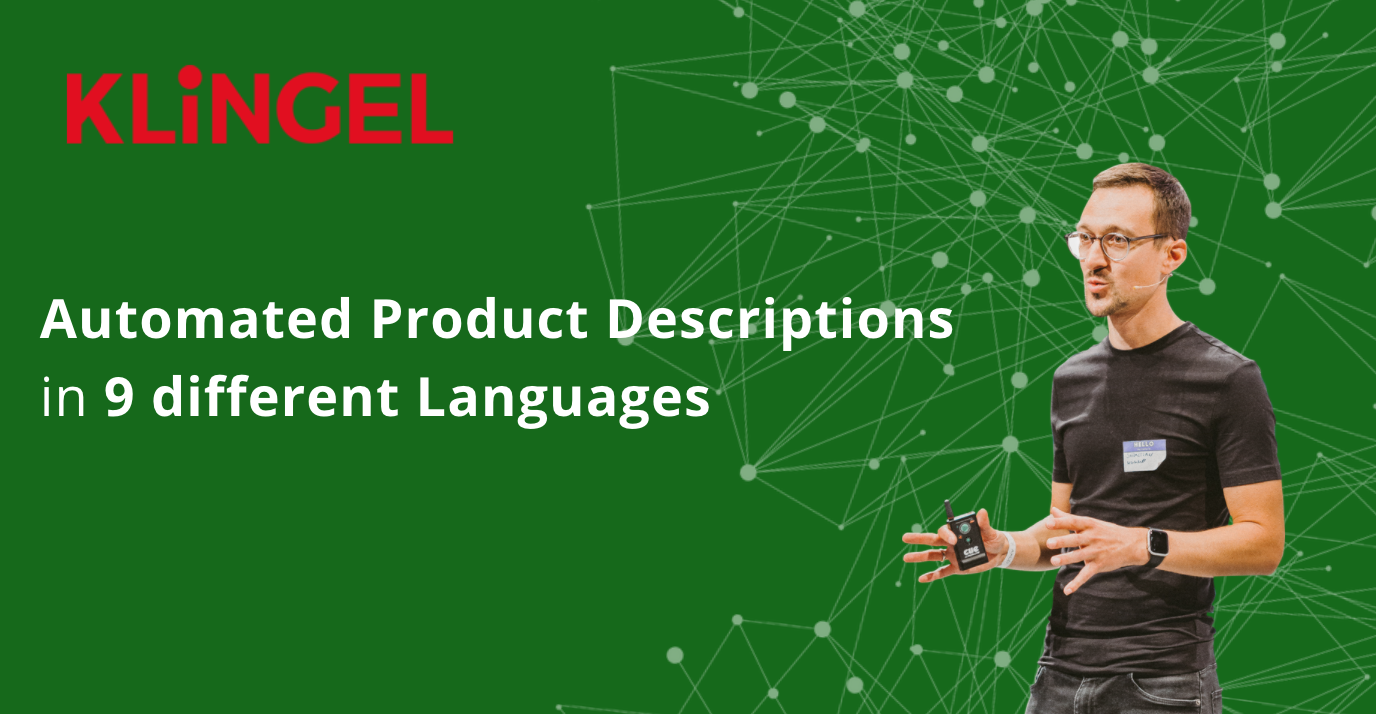E-Commerce | Customer Stories | Auto-Updating Copy | Automated Texts + Product Descriptions | GPT + RPA + DeepL | Multilingual Product Texts
Internationalization in eCommerce: Automated Product Descriptions in 9 Languages
Reading Time 4 mins | November 7, 2019 | Written by: Lisa Eppenstein

Reading Time: 3 minutes
Hello Sebastian, many thanks for the interview today. Please tell our readers a little about you and your work at Klingel-Gruppe.
As a graduate in business administration with a focus on marketing, I always had a penchant for creativity, but I also devoted myself to the subject of IT very early on. This has been a constant feature of my working life so far. Starting with computer courses as a teenager and various positions in a communications agency with a focus on IT, I progressed to a short excursion with 1&1 and then founded a start-up on the subject of online service platforms. With each of these ventures, and now my current position as head of department in the Klingel Group in the area of IT/eCommerce, creativity and IT have been the common threads.
Within the Klingel Group I am responsible for product data with a team of about 30 people. From the creation and onboarding of article master data, enrichment within the PIM and MAM systems, translation in a TMS and refinement using AX Semantics, through to export to systems such as our approximately 60 international web shops, marketplaces, etc., we take care of both the subject matter and technical aspects of the smooth process and comprehensive customer information.
The Klingel Group has very well structured data at its disposal, which is an important basis for the quality of automated product descriptions. How did you achieve this?
We started in 2010 with the transformation of previous IT systems. In addition to a new web shop, we also introduced a PIM system from informatica at that time. Previously, the article information consisted of a skeleton-like catalogue text and a colour and size field, regardless of whether the article was fashion or hardware/home textiles. With the introduction of the PIM, we restructured our product data together with the Stuttgart service provider parsionate. A lot of time and capital were invested in this restructuring. We are talking about over 1,000 product groups – e.g., trousers, shirts, sneakers, etc. – which had to be redefined. Additionally, three million articles had to be completely reworked and translated. We have completed many iterations of this process, and the product groups have been adapted several times to the needs of our stakeholders--above all, those of our customers. Of course, there is a lot of manual effort behind this work, which we have reduced over time by introducing new, intelligent technologies. For example, for maintenance we have used a data crawler – priceintelligence.net – which crawls the Web and makes available further article and assortment information as well as current prices. Thanks to the more comprehensive article information and higher quality, up-to-date data, we are not only increasing demand but are also reducing our returns and customer service calls.
The Klingel Group is internationally positioned. How do you implement the international product descriptions with AX Semantics?
With our 15 brands, we are active in 12 European countries and 9 languages. The basis for the automated product descriptions is structured data – attribute-value pairs – in PIM, which are already “pre-translated” into the respective languages when the German information is maintained. These translated values flow into AX Semantics via API during creation and as soon as relevant attribute values have changed, e.g., material compositions. Within AX Semantics, we have created content projects for the various brands and implemented their rule sets in the respective languages. The first implementation and the following regular and seasonal adjustments take place via AX’s web front end, through our country branches, or via outsourcing to marketplace service providers such as unaice. The product descriptions in the different languages are generated permanently and fully automatically, so that – depending on the volume of changes – we can have the value change in all languages in detailed text in the shops, Amazon, ebay, online marketing, and customer service in the respective countries within a few minutes.
In the meantime, not only the digital channels benefit from the automated product descriptions, but also our print catalogues, in which the text is imported fully automatically in all languages.
Apart from internationalization, what are the most important successes in automating product descriptions?
For us the automation of repetitive tasks is essential; otherwise, due to the quantity of articles, we would not be able to provide brand-specific content economically in all languages. When it came to product descriptions, AX Semantics enabled us to achieve all our goals. Products no longer wait for publication because the product descriptions have not yet been written or translated. In the past we lost a lot of time, a lot of money, and finally a lot of customers. In particular, we have been able to massively reduce the time and effort required for the manual creation of text and the usual translations.
What does the near future hold for automated product content?
With AX Semantics and our new technologies, we very soon will be able not only to make permanent and above all event-related adjustments to millions of articles with short response times, but also to generate customer-specific text – e.g., related to their order history – in order to provide our customers with even better guidance.
